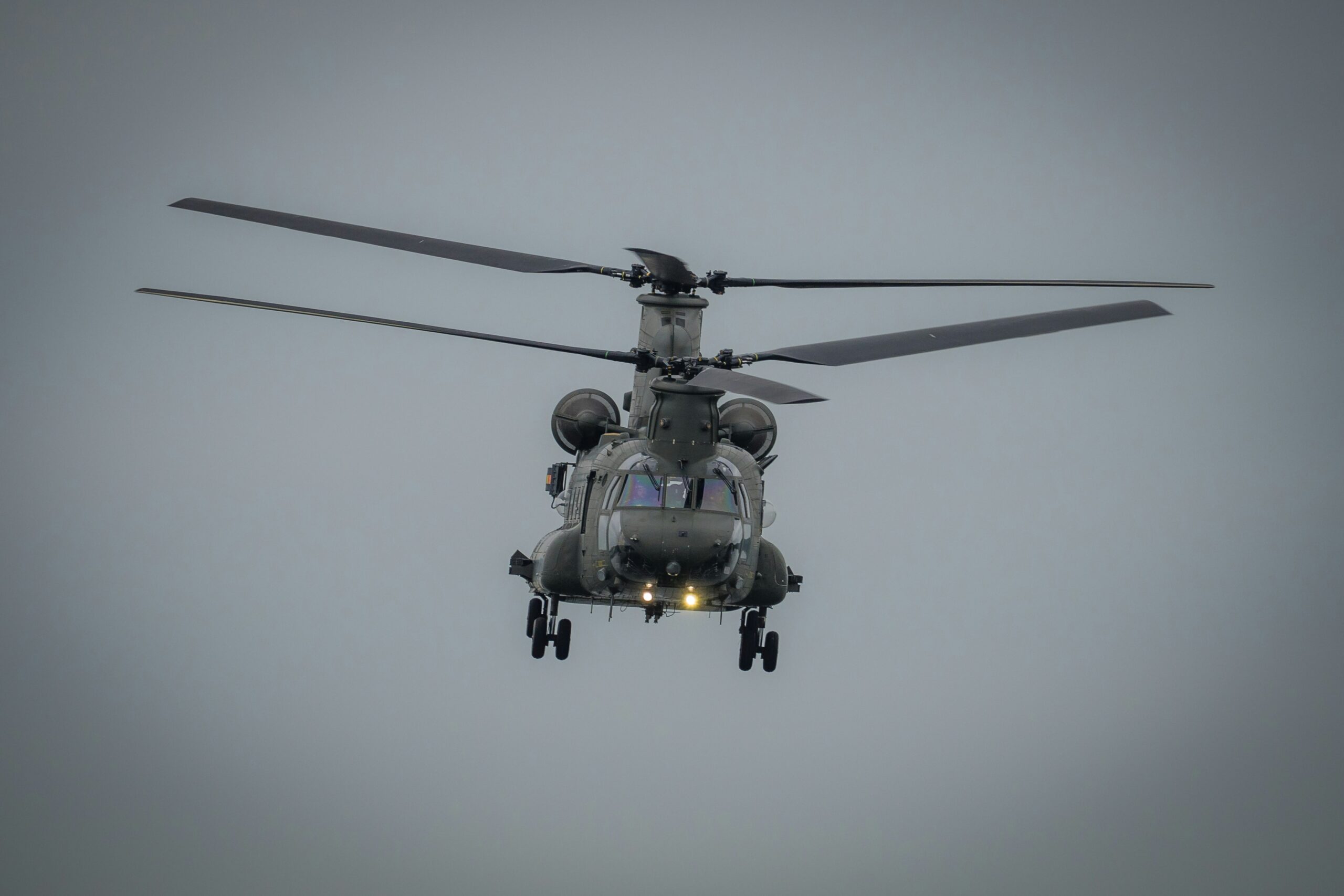Raytheon signed a firm-fixed-price deal worth $321,266,052. It covers:
- Full-rate production lots through late 2028
- Initial spare kits for each platform
- Field support teams during fleet install
- A $27.5 million slice tagged as Foreign Military Sales
Work splits between McKinney, Texas, and Forest, Miss. The Program Office set December 31 2028 as the last delivery marker, yet insiders say final batches may turn up earlier if parts flow steady.
Why the Radar Matters
Silent Knight sits under the nose or belly of four USSOCOM airframes:
- MH-47G Chinook
- MH-60M Black Hawk
- CV-22 Osprey
- MC-130H Combat Talon
Crews run low-level routes over hills, deserts, river beds, basically any place that hides them from radar nets. Night or foul weathr used to force bigger clearances. Silent Knight fixes that gap with real-time terrain pictures and quick climb/dive cues. That slice of time often spares a rotor blade—or a whole team.
Roots of the Project
Back in 2020 Raytheon pocketed a $235.6 million award for first production sets, later expanded under the Silent Knight radar contract. Early blocks flew on test Chinooks over the Rockies. Feedback rolled in fast: tweak screen brightness, shave a second off map refresh, cut false alerts in dust. By October 2022 a sharp $8.35 million tasking locked in those quick fixes for the CV-22 fleet.
Each sharpened slice built trust. When Program officers weighed bids in mid-2023, the track record looked solid. Raytheon’s tool chain was proven, the software crew reacted inside weeks, and flight test data beat the spec sheet. That chain of wins tipped the scale toward the bigger multiyear package signed 1 December 2023.
Inside the Assembly Flow
McKinney handles sensor boards, wave-guide blocks, and the main processor cage. Sub-assemblies ship by truck to Forest, where techs join power supplies, wrap cooling lines, then push everything into environmental chambers. A radar faces heat, rain-spray, ice shock—Forest’s test rigs cycle all three in one night, rough on seals yet catches leakers early.
Shipping crates roll next to Warner Robins or Hurlburt, depending on aircraft type. Field teams slot each unit during scheduled depot visits. First fit checks ran smoother than planners thought—one crew chief joked the harness holes “lined up like someone used a tape measure.” That comment, half-laugh half-relief, shows how tight cockpit real estate can be.
Core Capabilities
- Terrain-Following / Avoidance. The antenna sweeps ahead, builds a 3-D buffer, then feeds flight director bars. Pilots see climb arrows flash one full second sooner than with the legacy set.
- High-Resolution Map. Synthetic aperture mode drops a clear picture, even when moonlight is zero. No need to goose the brightness and kill night-vision tubes.
- Threat Mark-Up. Dynamic library tags known emitters, shoulder-fired zones, power-line corridors. Crew can blank layers they don’t need, so the screen never clutters.
- Weather Slice. A parallel channel looks for micro-bursts and icing bands. Instructors at Kirtland already work this mode into low-level syllabi.
Foreign Military Sales Thread
Partner nations running Chinooks or Ospreys eyed Silent Knight for years. The new contract finally carves $27.5 million for export tails. Raytheon’s legal shop screens every line of code, stripping items flagged as “U.S. Eyes-Only”. Once greenlit, engineers pin local threat tables, metric grid formats, plus radio presets. That keeps the core box common while letting each buyer fit home procedures. Similar approaches to building sovereign electronic warfare programming centers, like Australia’s AIR 5391 program milestone, show how localized capabilities can grow into key spectral warfare hubs.
Install kits differ in small ways—one ally asked for a slimmer control panel to clear a gunsight bracket—but most cabling stays standard. Common parts slash cost, and allied pilots train on the same sims, which shrinks exercise planning time.
Strategic Weight
Special ops flyers count on stealth in geography more than in paint. Hugging ground under cloud cuts radar cross-section by physics alone. Silent Knight gives crews that low lane without eating brain bandwidth. Fewer knob twists, fewer double-checks. That saved attention shifts to watching the L-Z or scanning for small-arms flashes.
From a command view, shared sensors tighten coalition links. Two nations with identical radar tapes can swap flight plans fast. Mission rehearsals no longer stall while teams convert altitudes or grid masks. With budgets tight, interoperability wins arguments in capital halls, as seen in the US Navy’s $646 million SPY-6 radar expansion contract.
Production Risks and Mitigation
Chip supply still bites across aerospace. Raytheon locked long-lead silicon early, yet a hiccup at one fab would ripple. Managers keep buffer lots—maybe not perfect economy, still cheaper than empty bins.
Another pinch: cockpit variance. MH-60M dashboards pack less space than C-130 racks. CAD models predict fit, yet cables snake differently in each fortress of wires. Integration squads carry spare brackets, extra ground straps, and a habit of late-night drill runs. They’ve learned the hard way a bolt half a turn shy rattles loose under rotor vibration.
Upgrade Paths on the Table
Software refresh in 2026 aims to:
- Boost map refresh to 20 Hz
- Auto-screen birds, power lines, wind-turbine blades
- Add anti-jamming shelf code
- Slide direct feed into future Link-66 waveform
Hardware tweaks are less certain. Cooling loops hold fine on H-47s, yet CV-22 bays run hotter in desert climbs. An optional heat pipe kit could roll if field data show margins slipping.
March 2025 Update
Assembly beat baseline by roughly five months. Ten radars shipped, eight already active. Chinook crews in 160th SOAR flew night-low over Kentucky ridges; cockpit tape reveals display latched contour lines sharp, no ghost echoes even in mist pockets. One pilot said the screen “felt almost boring”—meaning it just worked, no drama, which aviators treat as gold.
Abroad, two unnamed allies accepted first kits. Flight checks found only minor snags: a mis-aligned dimmer pot here, a cable slack there. Fix took an afternoon. Local maintainers praised Raytheon tech reps who “spoke plain, no jargon” during hand-over. That goodwill often counts more than a glossy manual.
At last month’s SOFIC expo, company spokespeople hinted at a maritime spin, maybe a P-8 pod, though official docs list it as concept only. Still, chatter shows Silent Knight brand may roam beyond rotorcraft.
Looking Ahead
Between now and 2028 the radar must stay ahead of denser air-defense nets and growing civil drone traffic. Roadmap talks mention machine-learning filters, yet developers vow not to dump raw AI buzz in the cockpit. They want predictable logic pilots can test, not a black-box guesser.
Budget cycles could add more buys. If allies choose block-upgrade routes together, unit price dips. That math sways bean-counters, yes, but also frees funds for training hours—arguably the bigger readiness lever.
Final Take
Silent Knight moved from sketch to fleet asset in less than a decade, a quick sprint by defense standards. The fresh $321 million order cements the radar as USSOCOM’s low-level backbone. Raytheon must still steer through supply jolts and varied airframes, yet early deliveries and good field notes point positive.
For pilots skimming ridges at two hundred feet, the box under the nose is no longer just another sensor. It’s eyes that never blink, even when sand, snow, or rain piles on the windshield. If the production rhythm holds and upgrades land on time, Silent Knight will likely guide special-ops aircraft long after this contract closes.
REFERENCE SOURCES:
- https://executivebiz.com/2024/06/rtx-subsidiary-books-potential-293m-socom-contract-for-silent-knight-radar-system-support/
- https://clearedcareers.com/blog/raytheon-awarded-321m-for-production-of-silent-knight-radar-systems/
- https://defence-blog.com/raytheon-awards-321m-contract-for-silent-knight-radar/
- https://www.army-technology.com/news/raytheon-to-continue-ussocom-silent-knight-radar-production/
- https://www.govconwire.com/2023/12/rtx-books-321m-socom-contract-for-silent-knight-radar-system-production/
- https://news.clearancejobs.com/2022/10/24/raytheon-awarded-software-contract-for-cv-22-silent-knight-radar/



